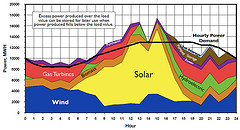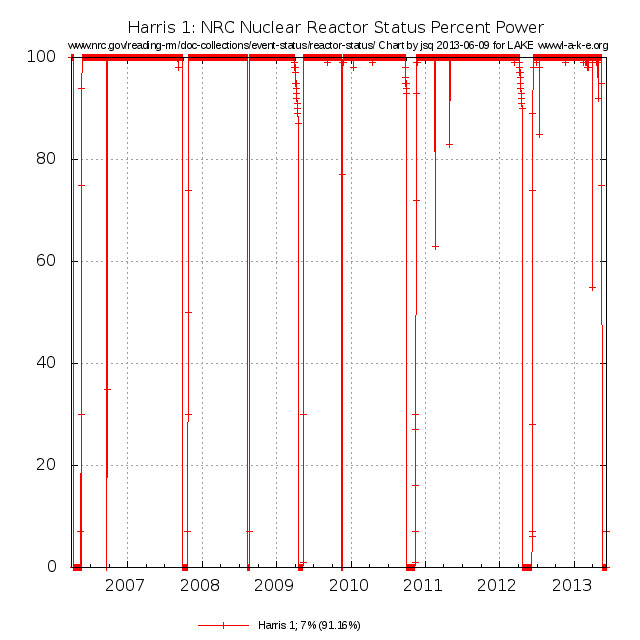Less than 500 miles from here in NC,
what else haven’t they found if
 ‘Duke Energy’s examination a year ago “was supposed to have found that problem then and fixed it”‘?
This was a ‘a quarter-inch spot the NRC and the company describe as a “flaw” in the reactor vessel head, which contains heat and pressure produced by the nuclear core’s energy.’
When a solar panel has a quarter-inch flaw, you get a tiny percentage less electricity,
not the risk of radiation leak or worse.
Would you rather have two more nukes at the same site, run by the same company that can’t run the one it’s got safely, or solar power instead?
‘Duke Energy’s examination a year ago “was supposed to have found that problem then and fixed it”‘?
This was a ‘a quarter-inch spot the NRC and the company describe as a “flaw” in the reactor vessel head, which contains heat and pressure produced by the nuclear core’s energy.’
When a solar panel has a quarter-inch flaw, you get a tiny percentage less electricity,
not the risk of radiation leak or worse.
Would you rather have two more nukes at the same site, run by the same company that can’t run the one it’s got safely, or solar power instead?
Plus where is the advantage of baseload capacity when Harris 1 has only been up 27.41% for the past month (NRC data), which is hardly better than the approximately 20% sun hours per day for solar power in North Carolina this time of year. Given the low and continually-dropping cost of solar panels, Duke could simply over-provision distributed solar panels and get way more than 20% or 27.41% effective power, and get that on budget and on time.
Emery P. Dalesio wrote for AP yesterday, Harris nuclear plant in U.S. is safe to restart after reactor problem found,
The Charlotte-based company’s Duke Energy Progress subsidiary last month was preparing for a plant shutdown and refuelling when operators reviewing ultrasonic tests done during last year’s refuelling found a problem. There was a quarter-inch spot the NRC and the company describe as a “flaw” in the reactor vessel head, which contains heat and pressure produced by the nuclear core’s energy.
The tiny flaw had not broken through the containment shell and there was no evidence of radiation leakage, the company and regulators said. A public meeting summarizing what else a special inspection team found during more than two weeks looking into the problem at Harris — and why finding the spot was delayed for a year — is scheduled for Thursday. A final report is expected next month.
 That will be an interesting meeting and an interesting report.
Meanwhile, Duke
is still proposing to build two more reactors at the same site.
They don’t seem to know how to operate the one they’ve got.
Back to the AP story:
That will be an interesting meeting and an interesting report.
Meanwhile, Duke
is still proposing to build two more reactors at the same site.
They don’t seem to know how to operate the one they’ve got.
Back to the AP story:
Duke Energy’s examination a year ago “was supposed to have found that problem then and fixed it,” said Dave Lochbaum, who directs the nuclear safety project at the Union of Concerned Scientists. “It didn’t work that way. So one of the questions the NRC team will be answering is, why was it missed back then? … Somehow that system broke down.”
Nuclear plants and the operations in place to run them safely are designed with backups and safeguards, so it’s unlikely someone had a bad day and simply overlooked the spot, Lochbaum said. Were the test results not clear enough?, he wonders. Did the process of reading the findings somehow fail? Was this an isolated case or something more worth alerting operators of the rest of the country’s 100-plus nuclear reactors?
“The detection that was available last year wasn’t fully appreciated until this year. That’s not how the system is supposed to work,” Lochbaum said.
Duke Energy said last week it fixed the problem detected on the underside of the top of the four-story reactor vessel that houses the nuclear chain reaction.
It’s a fix applied at more than a dozen commercial reactors around the country since the recurring problem was first discovered more than a decade ago, Lochbaum said.
“This comes with the industry. It’s an operational risk of running a nuclear power plant,” said Phil Adams, a senior bond analyst at Gimme Credit LLC, which provides investors with independent corporate bond research. “You’re dealing with high pressures and substances which can be very corrosive, and therefore inspections need to be very, very vigilant. So is it a big deal that you missed it on an inspection? Yeah, it is.”
It’s the sort of operational risk that’s made centralized baseload nuclear a bad investment, now even worse with San Onofre down for good, taking more than half a billion dollars with it. How many other “flaws” have there at Harris been to account for all these downtimes in the past seven years?
And look at this:
Nuclear Regulatory Commission inspectors are promising to share what they found when they inspected early signs of corrosion and cracking inside the reactor vessel’s covering.
This is the same NRC that said, in response to questioning by Kendra Ulrich of Friends of the Earth, that it’s “never been a practice” to show licensee documents to the public.
 What do you think about that, public?
When we know
all of North Carolina can be powered with
a smart grid of solar, wind, hydro, and less natural gas than NC uses now?
What do you think about that, public?
When we know
all of North Carolina can be powered with
a smart grid of solar, wind, hydro, and less natural gas than NC uses now?
-jsq
Short Link:


Pingback: Korean nuke supplier for Plant Vogtle forged documentation for “a host of nuclear reactors” | On the LAKE front